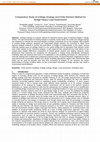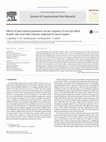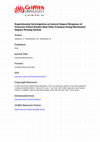Papers by David Thambiratnam

Aesthetics and functionality requirements have made most buildings asymmetric in recent times. Su... more Aesthetics and functionality requirements have made most buildings asymmetric in recent times. Such buildings exhibit complex vibration under dynamic loads as there is coupling between the lateral and torsional components of vibration, and are referred to as torsionally coupled buildings. These building require three dimensional modelling and analysis. In spite of much recent research and some successful applications of damage detection and assessment methods to civil structures in recent years, the applications to asymmetric buildings remains a challenging task for civil engineers. Less investigation has been made on the methodologies for detecting and locating damage specific to torsionally coupled asymmetric buildings. This paper aims to investigate and compare the difference in vibration behavior between symmetric and asymmetric buildings and the use of vibration characteristics for predicting damage in them. The need for developing a special method to detect damage in asymmetric buildings becomes evident. Towards this end, the paper presents a technique based on a modified version of the traditional modal strain energy method. The modified approach is developed from Stubbs’ modal strain energy damage index by decomposing the mode shape into lateral and vertical components. The procedure is illustrated through numerical studies conducted on a three dimensional five-story symmetric and asymmetric frame structure with the same layout. Vibration parameters obtained from finite element analysis of the intact and damaged building models are then applied into the proposed algorithms for detecting and locating the damage in these buildings.
This publication contains conference proceedings. Reproduction, but not modification, is permissi... more This publication contains conference proceedings. Reproduction, but not modification, is permissible without the authors' consent provided that the authors' work is referenced appropriately. No modification of the contents of this publication is allowed. The Organising Committee and Queensland University of Technology are not responsible for the statements or opinions expressed in this publication. Any statements or views expressed in the papers contained in these Proceedings are those of the author(s). Mention of trade names or commercial products does not constitute endorsement or recommendation for use. Notice: Changes introduced as a result of publishing processes such as copy-editing and formatting may not be reflected in this document.

This paper reports a study on the failure of masonry walls subject to vehicular impacts. The inve... more This paper reports a study on the failure of masonry walls subject to vehicular impacts. The investigation encompasses a homogenised masonry material model incorporating strain rate effects suitable for impact dynamic applications using a layered shell element formulation in an explicit finite element framework. As the focus of the study was on the impact failure of masonry walls, for simplicity the impactor was conservatively modelled as rigid and crashing normal to the surface of the masonry wall. The failure mode, contact-impact forces and the impact energy dissipation characteristics of the masonry wall are reported. It is shown that with the increase in impact velocity, the damage area of the masonry wall reduces, progressively plateuing equal to the contacting area of the impactor. This phenomenon is defined in this paper using a parameter termed as damage index, which is the ratio of the area of the damage of the wall to the area of the impactor at the contact-impact zone. Damage index is shown to be a useful parameter to assess the velocity of the impacting vehicles for forensic investigations. Sensitivity of the incident velocity of the impactor to the characteristics of the global vibration and local damage of the impacted masonry wall is reported; the exit velocity of the impactor is also reported. Examination of the effect of the aspect ratio, boundary conditions and the position of impact relative to the supported edges shows that these parameters are not sensitive to local impact failures.

Most structures are built to have a long life. However, during this long life, they can be incurr... more Most structures are built to have a long life. However, during this long life, they can be incurred damage due to structural deterioration, environmental effects and random actions such as impacts. Early damage assessment and appropriate retrofitting will enable the continued safe and efficient functions of the structures. In this context, vibration based techniques have emerged with the potential for reliable damage assessment. This study develops a dual criteria approach based on the vibration characteristics for detecting and locating damage in arch bridges. Steel arch bridges are one of the aesthetically pleasing bridge types in which damage has been rarely studied. In particular, the arch rib and struts (or columns in deck type bridges) which are important structural components, have received much less attention in damage detection. This study will therefore focus on damage detection in arch bridge structural components using indices based on modified Modal Flexibility (MF) and Modal Strain Energy (MSE) methods. The study is carried out through numerical simulations supported by limited experimental testing. The modelling techniques are first validated through experimental testing of a laboratory scale arch bridge model and this is followed by damage detection studies in this bridge structure. Data obtained from finite element analyses of the healthy and damaged arch bridge models are applied into the modified MF and MSE algorithms for detecting and locating the damage. Results demonstrate that the proposed method is capable of detecting damage in the arch rib and vertical columns of deck type arch bridges.

Science & Engineering Faculty, Apr 18, 2017
Grillage analogy is a popular method for analyzing various types of highway bridges in design off... more Grillage analogy is a popular method for analyzing various types of highway bridges in design offices. For load assessment of existing bridges in Australia, mainly beam line model and grillage analogy are employed to evaluate the structural integrity of bridge components due to live loadings. With majority of existing bridge networks designed per superseded design vehicles, the necessity to utilize more rigorous analysis methods to assess the load effects of bridges is indispensable. In this paper, various vehicular loading cases on grillage model of a box girder bridge with its equivalent finite element model were made. Based on the numerical analysis, it was observed that component-level load effects of two models have notable differences irrespective of vehicle speed, position and loading. However, when global-level load responses are compared, the discrepancy in outputs drops dramatically. Developed modelling ratios are practical and found to be applicable to any modelling techniques for assessment of vehicular loading both in global and component-response basis. Proposed flowchart suggested for heavy load assessment incorporates detailed and simple modelling approaches aligned with experimental data which can be used for periodic and long term monitoring of bridges. It can enhance the proper determination of bridge condition states, as any conservative estimation of bridge capacity may result in unnecessary load limitations.

International Journal of Structural Stability and Dynamics, Sep 1, 2020
Vibration-based methods can be used to detect damage in a structure as its vibration characterist... more Vibration-based methods can be used to detect damage in a structure as its vibration characteristics change with physical changes in the structure. Arch bridge is a popular type of bridge with rather complex vibration characteristics which pose a challenge for using existing vibration-based methods to detect damage in the bridge. Further, its particular geometry with a curved arch rib and vertical members (either in compression or tension) to support the horizontal deck makes the process of damage quantification using vibration-based methods harder and challenging. This paper develops and presents a vibration-based method that utilizes damage pattern changes in frequency response functions (FRFs) and artificial neural networks (ANNs) to locate and quantify damage in the rib of deck-type arch bridge, which is the most important load bearing component in the bridge. Principal component analysis, which is performed to reduce the dimension of original FRF data series and to obtain limited principal component analysis (PCA)-compressed FRF data is used in the development of the proposed method. FRF change, which is the difference in the FRF data between the intact and the damaged structure, is compressed to a few principal components and fed to ANNs to predict the location and severity of structural damage. The process and the hierarchy of developed ANN systems are presented, including the “fusion network” concept, which individually analyses FRF-based damage indicators separated by sensor locations. Finally, results obtained for many tested damage cases (inverse problems) are presented, which demonstrate the applicability of the proposed method for locating and quantifying damage in the rib of deck type arch bridge.

Journal of Constructional Steel Research, Nov 1, 2017
Concrete-filled double-skin steel tubes (CFDSTs), which consist of two concentric steel tubes wit... more Concrete-filled double-skin steel tubes (CFDSTs), which consist of two concentric steel tubes with concrete sandwiched between them, have found increasing use as a new sustainable alternative to existing structural bridge piers and building columns, over the recent years. They can hence become vulnerable to lateral impact loads such as those from collision of vehicles, vessels, barges or flying debris from a nearby explosion. This paper treats the response of such columns under a combination of static axial and dynamic lateral impact loads using a fully coupled numerical analysis with the finite element code LS-DYNA. The capability of the numerical model to trace the response and to predict the failure modes of the columns has been validated using extensive results from experiments carried out recently at Queensland university of Technology. A parametric sensitivity analysis is conducted to investigate the effects of several load-related parameters on the key response of the CFDST columns. Results provide new information on the impact response of CFDST columns and the effects of controlling parameters to form an extensive database. This can be employed to develop appropriate equations and design calculation methods for CFDST columns under lateral impact loading.
Construction and Building Materials, Jul 1, 2017
h i g h l i g h t s Differential axial shortening in composite concrete filled tube columns is ev... more h i g h l i g h t s Differential axial shortening in composite concrete filled tube columns is evaluated. Effects of creep, shrinkage and time dependent concrete properties are considered. Construction sequence, concrete levelling and stress relaxation are also included. Differential axial shortening of a CFT building is compared with a RC building.
Structure and Infrastructure Engineering, Aug 4, 2023

IGI Global eBooks, 2016
Structural Dynamics has gained prominence recently due to (i) vibration problems in slender struc... more Structural Dynamics has gained prominence recently due to (i) vibration problems in slender structures that have emerged as a result of new materials technology and aesthetic requirements, (ii) ageing bridge structures whose health needs to be monitored and appropriate retrofitting carried out to prevent failure and (iii) increased vulnerability of structures to seismic, impact and blast loads. Knowledge of structural dynamics is necessary to address these issues and their consequences. In recent times, structural dynamics research has generated considerable amount of new knowledge to address these issue, but this is not readily available to practicing engineers as very little or none of it enters the class rooms. This paper argues for the need to include structural dynamics and the new research knowledge into the syllabus of all civil engineering courses, especially those with a major in structural engineering. This will enable our future structural engineers to design and maintain safe and efficient structures.

For the purpose of assessment, bridges are load tested with known truck loads which is not always... more For the purpose of assessment, bridges are load tested with known truck loads which is not always feasible due to budget constraints and traffic interruptions. To address this issues, this paper demonstrates the purpose and benefits of an initial finite element model ( FEM ) of a reinforced concrete box girder. Firstly, a detailed FEM representing ‘as-new’ condition of the bridge is provided, then parameters to include in the FEM before and after model updating are identified. Lastly, preparation of the scheme for field testing using pre-test FEM data is shown. The first two mode shapes of the bridge had sway in lateral and longitudinal directions, whereas the third and fourth modes were flexural and torsional respectively. It was found that variation in girder cross section, supports fixity at abutment and pier had significant effects on the modal characteristics; which were identified as controlling parameters prior to model updating. Based on modal model of the bridge, decisions were made with respect to excitation source, instrumentation plan and modal analysis techniques for field testing which will be conducted in the near future.
Faculty of Built Environment and Engineering, 2006

Vibration based damage detection (VBDD) techniques are widely adopted in the structural health mo... more Vibration based damage detection (VBDD) techniques are widely adopted in the structural health monitoring field due to their simplicity, practicability and cost effectiveness. The underlying principle of VBDD technique is that damage changes physical properties (stiffness, mass and damping) of a structure which then alters the modal properties (natural frequencies and mode shapes) of the structure. These changes in modal properties can be measured and applied into the algorithms based on modal flexibility and modal strain energy to locate and quantify structural damage. A research program is underway to develop a procedure for detecting, locating and quantifying damage in slab-on-girder bridges. Towards this end, a vibration based damage index which is representative of damage intensity, is developed in terms of the changes in three vibration parameters, namely natural frequency, modal flexibility and modal strain energy. This multi-criteria approach is undertaken as each vibration parameter could have advantages over the other under different circumstances. This paper presents the early part of the research which treats beams using numerically simulated modal data from numerical models that have been validated against experimental results. Results show that the proposed multi-criteria approach is capable of detecting, locating and quantifying damage in beams using the modal properties of the first three modes

Structural Health Monitoring-an International Journal, Nov 3, 2018
For assessment of existing bridges, load rating is usually performed to assess the capacity again... more For assessment of existing bridges, load rating is usually performed to assess the capacity against vehicular loading. Codified load rating can be conservative if the rating is not coupled with the field data or if simplifications are incorporated into assessment. Recent changes made to the Australian Bridge assessment code (AS 5100.7) distinguishes the difference between design and assessment requirements, and includes addition of structural health monitoring (SHM) for bridge assessment. However, very limited guidelines are provided regarding higher order assessment levels where more refined approaches are required to optimize the accuracy of the assessment. This paper proposes a multi-tier assessment procedure for capacity estimation of existing bridges using a combination of SHM techniques, advanced nonlinear analysis, and probabilistic approaches to effectively address the safety issues on aging bridges. Assessment of a box girder bridge was carried out according to the proposed multi-tier assessment, using data obtained from modal and destructive testing. Results of analysis at different assessment tiers showed that both load carrying capacity and safety index of the bridge vary significantly if current bridge information is used instead of as-designed bridge information. Findings emerged from this study demonstrated that accuracy of bridge assessment is significantly improved when SHM techniques along with reliability approaches and nonlinear finite element analysis are incorporated, which will have important implications that are relevant to both practitioners and asset managers.

Experimental Mechanics, Mar 28, 2016
This paper presents an experimental investigation on the lateral impact performance of axially lo... more This paper presents an experimental investigation on the lateral impact performance of axially loaded concretefilled double-skin tube (CFDST) columns. These columns have desirable structural and constructional properties and have been used as columns in building, legs of off shore platforms and as bridge piers. Since they could be vulnerable to impact from passing vessels or vehicles, it is necessary to understand their behaviour under lateral impact loads. With this in mind, an experimental method employing an innovative instrumented horizontal impact testing system (HITS) was developed to apply lateral impact loads whilst the column maintained a static axial pre-loading to examine the failure mechanism and key response parameters of the column. These included the time histories of impact force, reaction forces, global lateral deflection and permanent local buckling profile. Eight full scale columns were tested for key parameters including the axial load level and impact location. Based on the test data, the failure mode, peak impact force, impact duration, peak reaction forces, reaction force duration, column maximum and residual global deflections and column local buckling length, depth and width under varying conditions are analysed and discussed. It is evident that the innovative HITS can successfully test structural columns under the combination of axial pre-loading and impact loading. The findings on the lateral impact response of the CFDST columns can serve as a benchmark reference for their future analysis and design.
Thin-walled Structures, Nov 1, 2016
Concrete-filled double-skin steel tubes (CFDSTs) find increasing use as bridge piers and building... more Concrete-filled double-skin steel tubes (CFDSTs) find increasing use as bridge piers and building columns. This paper treats the impact response of such columns using numerical simulations. The modelling techniques are validated using experimental results to establish the capability of the numerical model to capture the impact response and failure modes of the column. The validated numerical model was used to carry out a parametric study on the effects of several structure-related parameters on the impact response of the CFDST columns. The findings of this paper can be used to develop appropriate design information for CFDST columns under lateral impact loading.

Structural Health Monitoring-an International Journal, Jan 18, 2019
Vibration characteristics of a structure can be used as an indication of its state of structural ... more Vibration characteristics of a structure can be used as an indication of its state of structural health as they vary if the structural health is affected by damage. This is the broad principle used in structural health monitoring for vibration based damage detection of structures. Though most structures are built to have a long life span, they can incur damage due to many reasons. Early damage detection and appropriate retrofitting will enable the continued safe and efficient functioning of structures. This study develops and applies a dual criteria method based on vibration characteristics to detect and locate damage in arch bridges. Steel arch bridges are one of the most aesthetically pleasing bridge types, which are reasonably popular in Australia and elsewhere. They exhibit three dimensional and somewhat complex vibration characteristics that may not be suitable for traditional vibration based damage detection methods. There have been relatively fewer studies on damage detection in these bridge types, and in particular the arch rib and struts which are important structural components, have received little attention for damage detection. This study will address this research gap and treat the damage detection in the arch bridge structural components using the dual criteria method to give unambiguous results. The proposed method is first validated by experimental data obtained from testing of a laboratory arch bridge model. The experimental results are also used to validate the modelling techniques and this is followed by damage detection studies on this bridge model as well as on a full scale long span arch bridge. Results demonstrate that the proposed dual criteria method based on the two damage indices can detect and locate damage in the arch rib and vertical columns of deck type arch bridges with considerable accuracy under a range of damage scenarios using only a few of the early modes of vibration.

Advances in environmental engineering and green technologies book series, May 24, 2011
Acoustic emission (AE) is the phenomenon where high frequency stress waves are generated by rapid... more Acoustic emission (AE) is the phenomenon where high frequency stress waves are generated by rapid release of energy within a material by sources such as crack initiation or growth. AE technique involves recording these stress waves by means of sensors placed on the surface and subsequent analysis of the recorded signals to gather information such as the nature and location of the source. It is one of the several diagnostic techniques currently used for structural health monitoring (SHM) of civil infrastructure such as bridges. Some of its advantages include ability to provide continuous in-situ monitoring and high sensitivity to crack activity. But several challenges still exist. Due to high sampling rate required for data capture, large amount of data is generated during AE testing. This is further complicated by the presence of a number of spurious sources that can produce AE signals which can then mask desired signals. Hence, an effective data analysis strategy is needed to achieve source discrimination. This also becomes important for long term monitoring applications in order to avoid massive date overload. Analysis of frequency contents of recorded AE signals together with the use of pattern recognition algorithms are some of the advanced and promising data analysis approaches for source discrimination. This paper explores the use of various signal processing tools for analysis of experimental data, with an overall aim of finding an improved method for source identification and discrimination, with particular focus on monitoring of steel bridges.

Heliyon, Jul 1, 2020
The increasing trend of using light and slender deck in pedestrian bridge has raised the issue of... more The increasing trend of using light and slender deck in pedestrian bridge has raised the issue of instability under pedestrian movement. The suspension pedestrian bridges are more vulnerable as lateral vibration often occurred in such type of bridges. Hence, the current paper targeted to develop a pedestrian suspension bridge with a new type of composite deck using Glass Fibre Reinforced Polymer (GFRP) in the bottom layer and laminated glass in the top layer. The safety and serviceability of the developed pedestrian bridge is rigorously investigated. The performance of the suspension pedestrian bridge is comprehensively investigated by monitoring important response parameters such as stress, deflections, natural frequencies and accelerations under pedestrian loads and compared with current bridge design code requirements. The developed suspension pedestrian bridge with new type of composite deck could adhere the requirements of the bridge design code. Hence, the suspension pedestrian bridge mentioned in this paper is recommended for pedestrian use for its standard safety and serviceability.











Uploads
Papers by David Thambiratnam